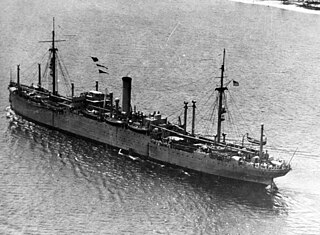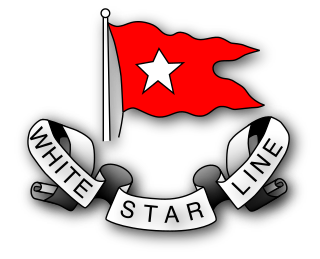Related Research Articles

An ocean liner is a type of passenger ship primarily used for transportation across seas or oceans. Ocean liners may also carry cargo or mail, and may sometimes be used for other purposes. Only one ocean liner remains in service today.

SS Chelyuskin was a Soviet steamship, reinforced to navigate through polar ice, that in 1934 became ice-bound in Arctic waters during a navigation along the Northern Maritime Route from Murmansk to Vladivostok and sank. 111 people were on board the Chelyuskin, and all but one were rescued by air. The expedition's task was to determine the possibility to travel by non-icebreaker through the Northern Maritime Route in a single navigation season.

SS Deutschland was a 21,046 gross registered ton (GRT) German HAPAG ocean liner which was sunk in a British air attack on May 3, 1945. Before the sinking, between April 16 and 28 1945, the concentration camp of Neuengamme was systematically emptied of all its remaining prisoners, other groups of concentration camp inmates and Soviet POWs; with the intention that they would be relocated to a secret new camp. In the interim, they were to be concealed from the advancing British and Canadian forces; and for this purpose the SS assembled a prison flotilla of decommissioned ships in the Bay of Lübeck, consisting of the liners Cap Arcona and Deutschland, the freighter Thielbek, and the motor launch Athen [de]. Since the steering motors were out of use in Thielbek and the turbines were out of use in Cap Arcona, Athen was used to transfer prisoners from Lübeck to the larger ships and between ships;[14] they were locked below decks and in the holds, and denied food and medical attention. All people on board the Deutschland survived the attack, though two accompanying vessels sank with great loss of life.
A ship's hold or cargo hold is a space for carrying cargo in the ship's compartment.

The following is a list of Registered Historic Places in Keweenaw County, Michigan.
This National Park Service list is complete through NPS recent listings posted May 19, 2023.

William Denny and Brothers Limited, often referred to simply as Denny, was a Scottish shipbuilding company.

Broomfleet railway station serves the village of Broomfleet in the East Riding of Yorkshire, England. The station is on the Selby Line 14+1⁄2 miles (23.3 km) west of Hull. The station, and all trains serving it, are operated by Northern. Formerly located on a quadrupled section of line with platforms on the outer ('slow') lines only, the station was rebuilt when the section from Gilberdyke was reduced to double track around 1987.

The United States H-class submarines were Holland 602 type submarines used by the United States Navy.

USS Rappahannock (AF-6) was a Rappahannock-class stores ship acquired by the U.S. Navy for use in World War I. She served in the dangerous North Atlantic Ocean, delivering animals, such as horses and steers on-the-hoof, to American Expeditionary Force troops in Europe.

SS City of Paris was a steam passenger ship launched in 1920 and completed in 1922 for the Ellerman Lines. She was requisitioned for service by the British government during the Second World War.
SS Norlantic was an American cargo ship of the Norlasco Steamship Company of New York that was scuttled after being damaged by German submarine U-69 in May 1942 with the loss of seven lives. The ship was built as SS Lake Fandango, a Design 1099 ship of the United States Shipping Board (USSB), in 1919 and had also sailed under the name SS Lexington.

SS West Eldara was a steel-hulled cargo ship built in 1918 as part of the United States Shipping Board's emergency World War I shipbuilding program.

Fort Victoria was a 7,784 GRT cruise ship which was built in 1912 as Willochra. During the First World War she was requisitioned for use as a troopship. In 1920 she was sold and renamed Fort Victoria, serving until lost in a collision in 1929.

SS Gallic was a cargo steamship built in 1918. During her career, she had six different owners and sailed under the flags of the United Kingdom, Panama and Indonesia. She underwent seven name changes during her 37-year career. She was scrapped at Hong Kong in 1956, the last surviving White Star Line cargo ship.
SS Maasdam was a Dutch steam merchant and was the third of five with this name in the Holland America Line. She was originally launched 21 October 1920, with a length of 466, beam of 58 feet and a tonnage of 8,812 GRT. Constructed at Rotterdam, she was originally designed as a combination cargo and passenger vessel. She had a crew of eighty-nine and originally showed two funnels, but only one was functioning. The ship laid up in 1933 and overhauled the next year with the dummy funnel and some passenger cabins removed, and crew size to forty-eight.
SS Loreto, formerly Astrée, was a 1,069 GRT cargo steamship that was built in England in 1912 for French owners and bought in 1933 by Italian owners who renamed her Loreto. In 1942 a Royal Navy submarine sank her in the Tyrrhenian Sea, killing 130 British Indian Army prisoners of war who were aboard.
SS James A. Wetmore was a Liberty ship built in the United States during World War II. She was named after James A. Wetmore, the Acting Supervising Architect of the United States, from 1915–1933.
SS William E. Dodd was a Liberty ship built in the United States during World War II. She was named after William E. Dodd, the United States Ambassador to Germany from 1933 to 1937.
SS Stepas Darius was a Liberty ship built in the United States during World War II. She was named after Steponas Darius, a Lithuanian American pilot, who died in a non-stop flight attempt with Lituanica from New York City to Kaunas, Lithuania, in 1933.
References
- ↑ "Ship lost with 13 men". The Times. No. 46630. London. 13 December 1933. col E, p. 12.
- ↑ "SS Broomfleet ? [+1933]". wrecksite.eu.